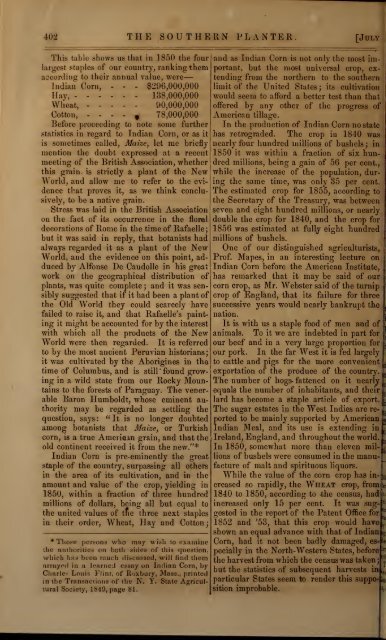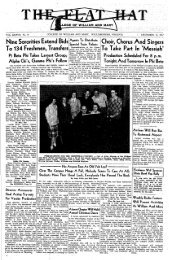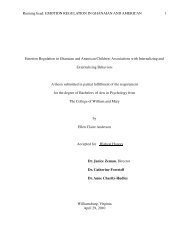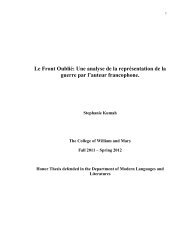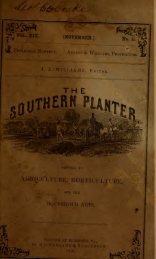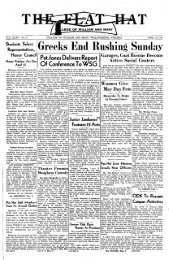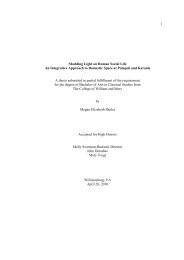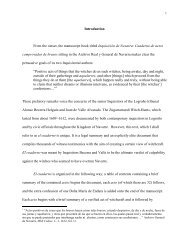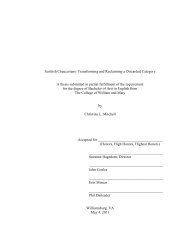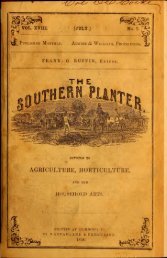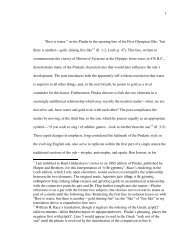Southern planter - The W&M Digital Archive
Southern planter - The W&M Digital Archive
Southern planter - The W&M Digital Archive
Create successful ePaper yourself
Turn your PDF publications into a flip-book with our unique Google optimized e-Paper software.
402 THE SOUTHERN PLANTER. [July<br />
This table shows us that in 1850 the four<br />
largest staples of our country, ranking them<br />
according to their annual value, were<br />
Indian Corn, - - - 821)0,000,000<br />
Hay, 138,000,000<br />
Wheat, 90,000,000<br />
Cotton, 78,000,000<br />
Before proceeding to note some further<br />
statistics in regard to Indian Corn, or as it<br />
is sometimes called, Maize, let me briefly<br />
mention the doubt expressed at a recent<br />
failed to raise it, and that Rafaelle's painting<br />
it might be accounted for by the interest<br />
with which all the products of the New<br />
World were then regarded. It is referred<br />
to by the most ancient Peruvian historians;<br />
it was cultivated by the Aborigines in the<br />
time of Columbus, and is still 'found growing<br />
in a wild state from our Rocky Mountains<br />
to the forests of Paraguay. <strong>The</strong> vener-<br />
able Baron Humboldt, whose eminent au-<br />
thority may be regarded as settling the<br />
question, says : " It is no longer doubted<br />
among botanists that Maize, or Turkish<br />
corn, is a true American grain, and that the<br />
old continent received it from the new."*<br />
Indian Corn is pre-eminently the great<br />
staple of the country, surpassing all others<br />
in the area of its cultivation, and in the<br />
amount and value of the crop, yielding in<br />
1850, within a fraction of three hundred<br />
millions of dollars, being all but equal to<br />
the united values of tnc three next staples<br />
in their order, Wheat, Hay and Cotton;<br />
* Those persons who may wish to examine<br />
the authorities on both sides of this question,<br />
which hits been much discussed, will find them<br />
arrayed in a learned essay on Indian Corn, by<br />
Charles Louis Flint, of Roxbury, Mass.. printed<br />
in the Transactions of the N. Y. State Agricultural<br />
Society, 1840, page 81.<br />
and as Indian Corn is not only the most im-<br />
portant, but the most universal crop, extending<br />
from the northern to the southern<br />
limit of the United States; its cultivation<br />
would seem to afford a better test than that<br />
offered by any other of the progress of<br />
American tillage.<br />
In the production of Indian Corn no state<br />
has retrograded. <strong>The</strong> crop in 1840 was<br />
nearly four hundred millions of bushels ; in<br />
1850 it was within a fraction of six hun-<br />
meeting of the British Association, whether, dred millions, being a gain of 56 per cent.,<br />
this grain is strictly a plant of the Newi while the increase of the population, dur-<br />
World, and allow me to refer to the eviing the same time, was only 35 per cent.<br />
dence that proves it, as we think conclu- <strong>The</strong> estimated crop for 1855, according to<br />
sively, to be a native grain.<br />
the Secretary of the Treasury, was between<br />
Stress was laid in the British Association seven and eight hundred millions, or nearly<br />
on the fact of its occurrence in the floral<br />
decorations of Rome in the time of Rafaelle;<br />
double the crop for<br />
1856 was estimated<br />
1840, and the crop for<br />
at fu% eight hundred<br />
but it was said in reply, that botanists had millions of bushels.<br />
always regarded it as a plant of the New One of our distinguished agriculturists,<br />
World, and the evidence on this point, ad- Prof. Mapes, in an interesting lecture on<br />
duced by Alfonse De Caudolle in his great Indian Corn before the American Institute,<br />
work on the geographical distribution of has remarked that it may be said of our<br />
plants, was quite complete; and it was sen- corn crop, as Mr. Webster said of the turnip<br />
sibly suggested that if it had been a plant of crop of England, that its failure for three<br />
the Old World they could scarcely have successive years would nearly bankrupt the<br />
nation.<br />
It is with us a staple food of men and of<br />
animals. To it we are indebted in part for<br />
our beef and in a very large proportion for<br />
our pork. In the far West it is fed largely<br />
to cattle and pigs for the more convenient<br />
exportation of the produce of the country.<br />
<strong>The</strong> number of hogs- fattened on it nearly<br />
equals the number of inhabitants, and their<br />
lard has become a staple article of export.<br />
<strong>The</strong> sugar estates in the West Indies are reported<br />
to be mainly supported by American<br />
Indian Meal, and its use is extending in<br />
Ireland, England, and throughout the world.<br />
In 1850, somewhat more than eleven millions<br />
of bushels were consumed in the manu-<br />
facture of malt and spirituous liquors.<br />
While the value of the corn crop has increased<br />
so rapidly, the Wheat crop, from<br />
1840 to 1850, according to -the census, had<br />
increased only 15 per cent. It was sug-<br />
gested in the report of the Patent Office for<br />
1852 and '53, that this crop would have<br />
shown an equal advance with that of Indian<br />
Corn, had it not been badly damaged, es-<br />
pecially in the North-Westcrn States, before llri<br />
the harvest from which the census was taken;<br />
but the statistics of subsequent harvests in<br />
particular States seem to render this suppo<br />
sition improbable.


